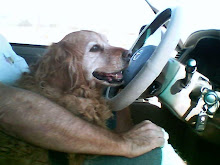Each part of the country has idiosyncratic behaviors or jargon. The same can apply to driving customs. Here are a few pointers for driving in the arid southwestern US.
1. Speed: On a 4-lane divided highway ( including interstates), it is customary to drive 5 miles above the speed limit (more than that in Texas). If you prefer to go at or under the speed limit, please stay in the right lane.
2. Passing or pulling over: If you're on a 2-lane undivided highway and are traveling at or under the speed limit, most western states have a mandatory-passing law. If you have 4 vehicles stacked up behind you (in some states it's actually 3!), you must pull over and allow them to pass. If you have been in this situation and not pulled over, this explains why the people who passed you gave you the one-finger salute.

3. Waving: Road shoulders are the easiest way to gauge whether a one-hand wave is customary when being passed by an oncoming car. If the road shoulder is wide and paved, you are not in wave country. If there is a car within a tenth of a mile in front of you, or more than 3 cars pass you going the other way in 5 minutes, you are not in wave country. If the shoulder is not paved or the paving only extends a foot or two past the line (or there is no line) then you should wave. The wave consists of two to three fingers being lifted from the steering wheel about 75 yards away. A head-nod is also a nice gesture to add. The photo above is a road on which waving is the norm.
4. In Texas, especially on the Farm to Market roads (numbered as FM XXX), folks will tailgate you if you are going too slow and there is a real shoulder on the road. It is really annoying and they don't back off. Sometimes they become more aggressive if you slow down. Per their rural custom, they expect you hang 2 tires on the shoulder to let them pass. This happens often, and sometimes is safe, sometimes not. Use your judgement or just pull over and let them go by.
5. Services: sometimes there aren't any for a long way. In Utah, the exit signs stating RANCH EXIT or RANCH ROAD mean just that. There are usually no services. Sometimes it's an hour or more (at 75 MPH) between places with fuel. Travel on the top half of your tank. Top 1/4 may be better. Some towns are very seasonal, so may have services in winter but not in summer or vice versa. Many times we've had folks surprised that it's another 18 miles from our town to the nearest fuel. When gas was $2 a gallon, folks would sell the stranded a couple of gallons for $10 ($5 for gas, $5 for the stupid tax). Now it costs more than the stupid tax to refill the gas can, so they're not as willing to help the poor planners.
6. Communications: There are lots of places your cell phone won't work. Even more where there's no Wi-Fi. Don't count on cell or e-mail to be your only communications back-up plan.
7. Water: ALWAYS have a gallon or two of water in your vehicle, preferably in portable sizes. If you have more than one person, then have more than one gallon. You may need someone to hike for communications or gas (see #5 and 6) so the person hiking needs some portable water and the folks left in the car need some too. If you are driving through places like Death Valley, more is better. Research this well in advance. Poor planning can be fatal. That's why it's still called Death Valley.
8. Being Prepared: I travel with a 72-hour kit in my vehicle that includes water, food, light and bedding. I also have a few yards of small-hole netting from Walmart (to use as bug screen if needed). Weather (flash floods, wind storms, dust storms, blizzards, etc.) may strand you. If you are prepared, it's an adventure. If you are not, it may be a death sentence.
9. Don't trust your GPS. If you are moving toward or through a potentially remote area, ask a local if your planned route will work at the specified time of year/weather. "Remote" can include going into mountains, road changing from paved to dirt, any pass over 6500 feet altitude, few town names on the map, lots of public land (national forest, national park, BLM range land), etc..
10. Personal business: There may be times when you can't get to a public facility. Carry toilet paper. Watch for critters before you bare your fanny. Either take the TP back and put it in your trash bag (stuff a grocery bag in the hole in the TP for this purpose) or bury it. No one wants to have your used TP hit them in the face next time the wind blows.
Overall, enjoy the journey. Don't race through the small towns for several reasons. First is that people live there. Go the speed limit or slower for safety and courtesy. Stop for lunch and a little local color. There are 'ghost towns' with a lot of history. Some are towns that once boasted tens of thousands of residents, but times have changed and only a few tough hold-outs remain. Other towns have been rediscovered by retirees or off-gridders and are full of life. If you see a lot of cars outside the cafe, and notice elderly people among the cafe's customers, eat there. The cars tell you it's favored by many. The elderly tell you that they have survived and returned for more!





